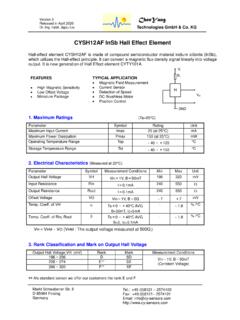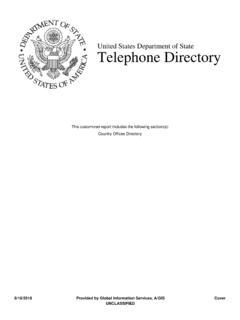Transcription of 01 Guide for Risk Assessment 14052010 - INSB Class
1 Guide for Risk AssessmentMay 2010 ALV ASNU R LVAENYSOI T BAUNRREEATUNIINSB ClassInternational Naval Surveys BureauGuide for Risk Assessment Guide for Risk Assessment Guide for Risk Assessment Issue date: 4 May 2010 Contents 1 General 3 Risk Assessment basic Terminology 3 Risk Assessment basic principles and ISM Code 3 Risk Assessment (RA) and Risk Management (RM) 4 Introducing risk Assessment in the Company/fleet 4 2 Risk Assessment process 5 Risk Assessment chart 6 Step 1. Identification of Shipboard operations/ tasks 7 Step 2. Identification of Hazards 7 Step 3. Identification of existing controls / measures 10 Step 4. Risk evaluation 10 Step 5. Risk reduction 13 Step 6. Review of Assessment 15 Guide for Risk Assessment Guide for Risk Assessment Issue date: 3 May 2010 INSB Class ISM ISPS Systems Dpt.
2 Page 3 of 16 Guide for Risk Assessment From its very nature, there is no unique Risk Assessment methodology to be applied in any context. There are no fixed rules how risk Assessment should be undertaken and the Assessment depends on the type of the ship, the nature of operations and the type and extend of the hazards and risks . Risk Assessment basic Terminology Accident: An unintended event involving fatality, injury, ship loss or damage, other property loss or damage, or environmental damage Consequence: The outcome of an accident Frequency: The number of occurrences per unit time ( per year) Hazard: A potential to threaten human life, health, property or the environment Risk: The combination of the frequency and the severity of the consequence.
3 Risk Assessment basic principles and ISM Code As defined in paragraph of the ISM Code (objectives), the requirement for the Assessment and management of risks is fundamental to the code. The ISM Code does not specify any particular approach to the management of risk, and it is for the company to choose methods appropriate to its organizational structure, its ships and its trades. The methods may be more or less formal, but they must be systematic, in order Assessment and response to be complete and effective and the entire process should be documented so as to provide evidence of the decision-making process. The principle of Safety Management involves managing and controlling risks levels of hazards and keeping them within acceptable levels.
4 This process involves seeking answers to following questions: 1. What could go wrong? 2. What happens if it goes wrong? 3. What are the chances to go wrong? 4. How could the chances/ effects be reduced? 5. What to do if it goes wrong? 6. How can we Manage risk levels? The first two questions involve identifying the hazards and prioritizing them based on the consequences. The third question determines the probability of occurrence or the frequency of occurrence of the hazard, and question number four involves risk reduction. Question number five involves emergency preparedness. Finally question number six involves safety Management. 1. General Guide for Risk Assessment Guide for Risk Assessment Issue date: 3 May 2010 INSB Class ISM ISPS Systems Dpt.
5 Page 4 of 16 Guide for Risk Assessment Risk Assessment (RA) and Risk Management (RM) The purpose of the RA and RM is to minimize risk to personnel, property and the environment. In this respect, all activities that could adversely affect Company s operations and performance are evaluated and appropriate measures are taken to ensure that risk is either reduced or maintained at an acceptable level. Risk is managed by identifying hazards, assessing consequences and probabilities and evaluating and implementing prevention and mitigation measures. Risk Assessment requires: Job familiarity Practical experience with the job Information regarding incident/ operation / activity Active participation of persons running the risk Open mind for any suggestions Proper application of the RA methodology Introducing risk Assessment in the Company/fleet In order a Company to introduce a structured risk Assessment program the following stages are suggested: Development of a risk Assessment methodology/procedure with relevant reports Communicate the new policy to the fleet and explain the need/benefits of same Training: through seminars and/or presentations and/or fleet circulars Identify who should carry out the risk assessments.
6 It is not necessary to involve everyone participates in the operation to participate in the risk Assessment of this operation. Usually used small teams but never only one person DPA (or risk expert) and/or Superintendents should advise the fleet of how risk assessments should be carried out onboard the vessel, by whom, when, how often Completed risk assessments should be submitted to the Company for analysis and review Guide for Risk Assessment Guide for Risk Assessment Issue date: 3 May 2010 INSB Class ISM ISPS Systems Dpt. Page 5 of 16 Guide for Risk Assessment Although there are many different RA methodologies, in general a usual approach is as follows: Step 1: Identification of shipboard operations / systems / tasks Step 2: Identification of Hazards Step 3: Identification of existing control measures Step 4: Risk Evaluation Calculation of risk Probability (or frequency) Determination Consequence (or Severity) Assessment Step 5: Risk Reduction Action and Timescale Identification and implementation of new Risk Control measures Step 6: Review of risk Assessment Evaluation of control measures Need for new risk Assessment Periodical review of risk Assessment Accidents / near misses 2.
7 Risk Assessment process Guide for Risk Assessment Guide for Risk Assessment Issue date: 3 May 2010 INSB Class ISM ISPS Systems Dpt. Page 6 of 16 Guide for Risk Assessment Risk Assessment chart Identification of Shipboard operations / activities Identification of hazards Identification of existing controls Assign Hazard severity Assign Hazard probability Determine Risk level Determine new Risk Controls Are controls reduce Risk to acceptable tolerable level Implement controls and timetable Periodical review of RA Are there changes? Are control effective? Review of control Yes No Yes No No Yes Guide for Risk Assessment Guide for Risk Assessment Issue date: 3 May 2010 INSB Class ISM ISPS Systems Dpt. Page 7 of 16 Guide for Risk Assessment Identification of shipboard operations / tasks requiring RA When to perform a risk Assessment RAs are conducted in order to identify and address potential hazards to personnel, property and the environment, for: a.
8 Existing shipboard operations/tasks b. in case of new operations/tasks c. in case of non-routine tasks d. in case of changes to procedures or equipment. e. in case of incidents, accidents, serious near misses, etc. f. prior to the introduction of new critical equipment or procedures. g. for preparation of complex or high risk jobs and projects. When deciding which operations/tasks to assess first, normally selected these which have the more potential of loss/harm to personnel, property and the environment, or to those related to the existing accident records. In practice the risks in the workplace should be assessed before work begins on any task which no valid risk Assessment exists.
9 Grouping work activities A useful approach is to identify separate work activities, to group them in a rational and manageable way and to gather the necessary information. Infrequent tasks/operations should also be included. Possible ways of grouping work activities: a. department/location b. stages of an operation/work c. planned/unscheduled maintenance d. defined tasks (routine/unroutine ones) Identification of Hazards What is a hazard? A hazard is simply a situation/condition which has the capability to cause damage, harm or other loss. A hazard can only be observed and recognized. Hazards are around us and cannot be taken away. Risk however can be identified, analyzed and dealt with. Step 1 Step 2 Guide for Risk Assessment Guide for Risk Assessment Issue date: 3 May 2010 INSB Class ISM ISPS Systems Dpt.
10 Page 8 of 16 Guide for Risk Assessment The hazard is the cause of an event/accident therefore should not be confused with the event itself ( hazard: fog event/accident: collision). In identifying a hazard the type of harm and to whom/what has also to be identified. Purpose The purpose of this step is to identify and generate a prioritized list of hazards, specific to the problem under review. This purpose is achieved by the use of standard techniques to identify hazards, which can contribute to accidents, and by screening these hazards using a combination of available data and judgment. Approach The approach used for hazard identification generally comprises a combination of both creative and analytical techniques, the aim being to identify as many relevant hazards as possible.








